Economics for Managers: Nestle Company Market Structure Report
VerifiedAdded on 2022/09/12
|7
|916
|22
Report
AI Summary
This report provides an in-depth analysis of the market structure of the Nestle Company, examining various aspects such as its corporate culture, product offerings, and competitive strategies. The report delves into Nestle's non-price competition tactics and the bargaining power dynamics with suppliers and buyers. A key component of the report is the performance evaluation, utilizing ratio analysis to assess profitability trends from 2017 to 2019, focusing on operating and net profit margins. The report also outlines Nestle's long-term goals, including its commitment to providing nutritious products and its environmental considerations. Finally, the report offers recommendations for improving performance and concludes with a summary of the key findings and references.

1
Economics for Manager
Economics for Manager
Paraphrase This Document
Need a fresh take? Get an instant paraphrase of this document with our AI Paraphraser
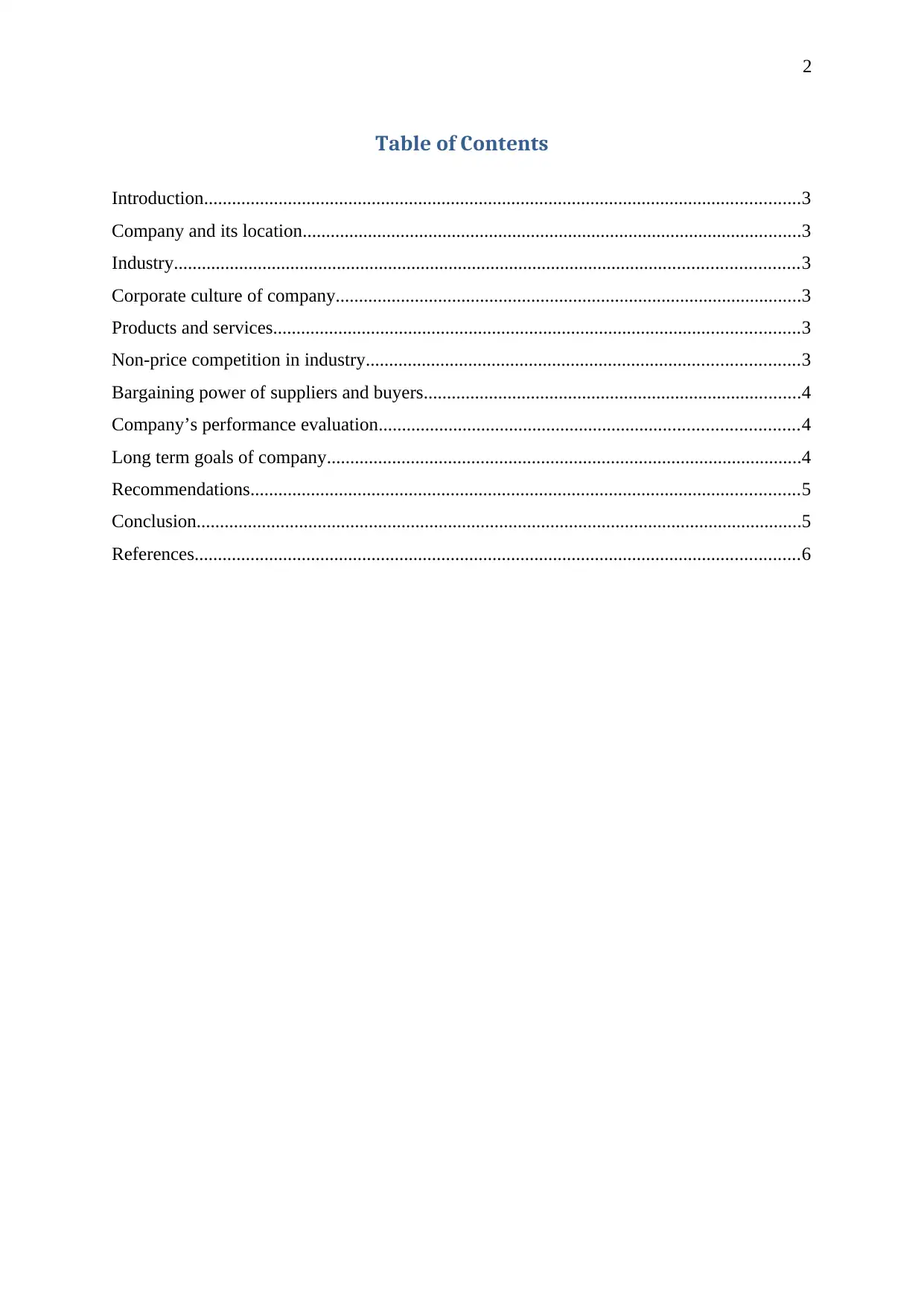
2
Table of Contents
Introduction................................................................................................................................3
Company and its location...........................................................................................................3
Industry......................................................................................................................................3
Corporate culture of company....................................................................................................3
Products and services.................................................................................................................3
Non-price competition in industry.............................................................................................3
Bargaining power of suppliers and buyers.................................................................................4
Company’s performance evaluation..........................................................................................4
Long term goals of company......................................................................................................4
Recommendations......................................................................................................................5
Conclusion..................................................................................................................................5
References..................................................................................................................................6
Table of Contents
Introduction................................................................................................................................3
Company and its location...........................................................................................................3
Industry......................................................................................................................................3
Corporate culture of company....................................................................................................3
Products and services.................................................................................................................3
Non-price competition in industry.............................................................................................3
Bargaining power of suppliers and buyers.................................................................................4
Company’s performance evaluation..........................................................................................4
Long term goals of company......................................................................................................4
Recommendations......................................................................................................................5
Conclusion..................................................................................................................................5
References..................................................................................................................................6
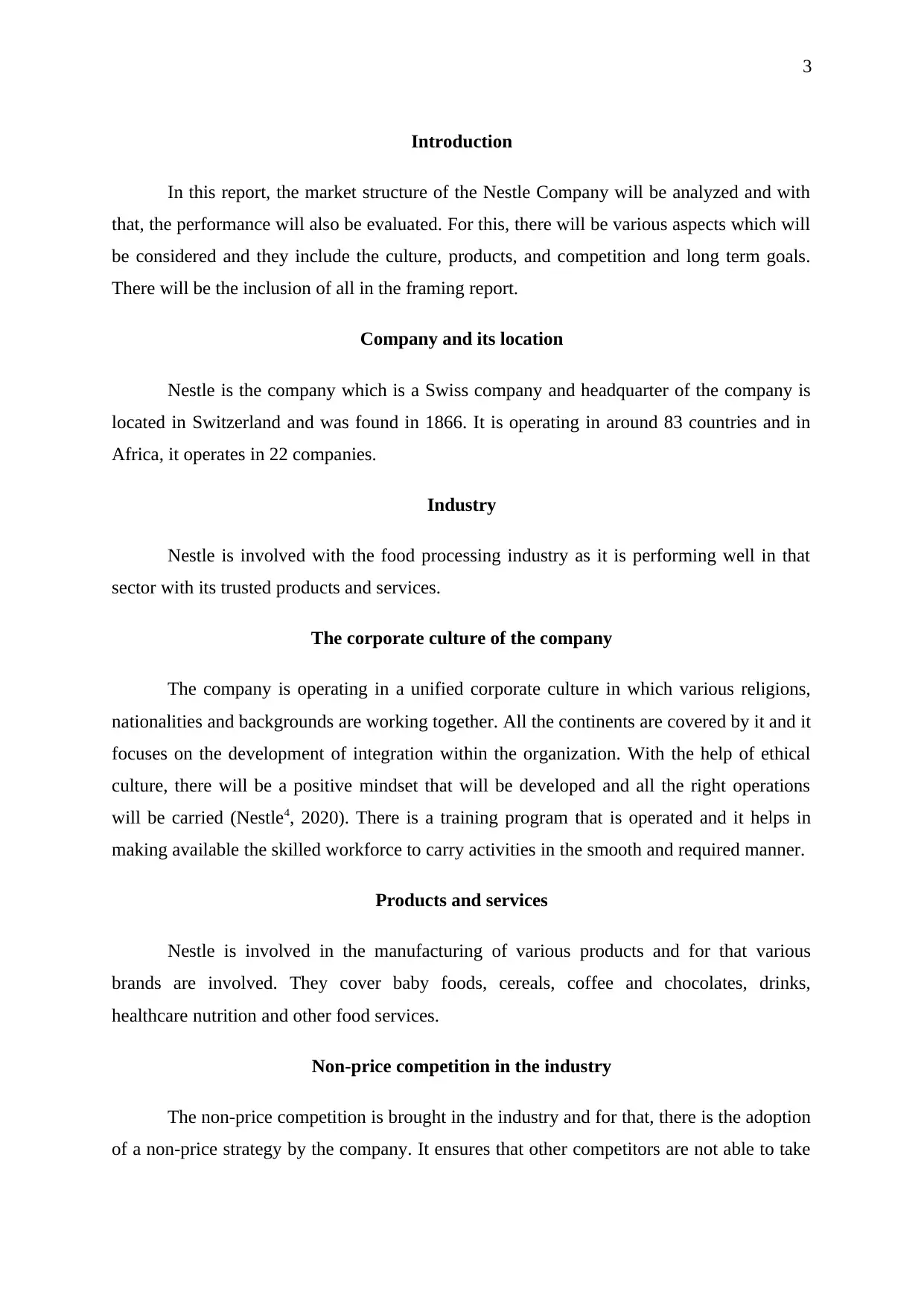
3
Introduction
In this report, the market structure of the Nestle Company will be analyzed and with
that, the performance will also be evaluated. For this, there will be various aspects which will
be considered and they include the culture, products, and competition and long term goals.
There will be the inclusion of all in the framing report.
Company and its location
Nestle is the company which is a Swiss company and headquarter of the company is
located in Switzerland and was found in 1866. It is operating in around 83 countries and in
Africa, it operates in 22 companies.
Industry
Nestle is involved with the food processing industry as it is performing well in that
sector with its trusted products and services.
The corporate culture of the company
The company is operating in a unified corporate culture in which various religions,
nationalities and backgrounds are working together. All the continents are covered by it and it
focuses on the development of integration within the organization. With the help of ethical
culture, there will be a positive mindset that will be developed and all the right operations
will be carried (Nestle4, 2020). There is a training program that is operated and it helps in
making available the skilled workforce to carry activities in the smooth and required manner.
Products and services
Nestle is involved in the manufacturing of various products and for that various
brands are involved. They cover baby foods, cereals, coffee and chocolates, drinks,
healthcare nutrition and other food services.
Non-price competition in the industry
The non-price competition is brought in the industry and for that, there is the adoption
of a non-price strategy by the company. It ensures that other competitors are not able to take
Introduction
In this report, the market structure of the Nestle Company will be analyzed and with
that, the performance will also be evaluated. For this, there will be various aspects which will
be considered and they include the culture, products, and competition and long term goals.
There will be the inclusion of all in the framing report.
Company and its location
Nestle is the company which is a Swiss company and headquarter of the company is
located in Switzerland and was found in 1866. It is operating in around 83 countries and in
Africa, it operates in 22 companies.
Industry
Nestle is involved with the food processing industry as it is performing well in that
sector with its trusted products and services.
The corporate culture of the company
The company is operating in a unified corporate culture in which various religions,
nationalities and backgrounds are working together. All the continents are covered by it and it
focuses on the development of integration within the organization. With the help of ethical
culture, there will be a positive mindset that will be developed and all the right operations
will be carried (Nestle4, 2020). There is a training program that is operated and it helps in
making available the skilled workforce to carry activities in the smooth and required manner.
Products and services
Nestle is involved in the manufacturing of various products and for that various
brands are involved. They cover baby foods, cereals, coffee and chocolates, drinks,
healthcare nutrition and other food services.
Non-price competition in the industry
The non-price competition is brought in the industry and for that, there is the adoption
of a non-price strategy by the company. It ensures that other competitors are not able to take
⊘ This is a preview!⊘
Do you want full access?
Subscribe today to unlock all pages.

Trusted by 1+ million students worldwide
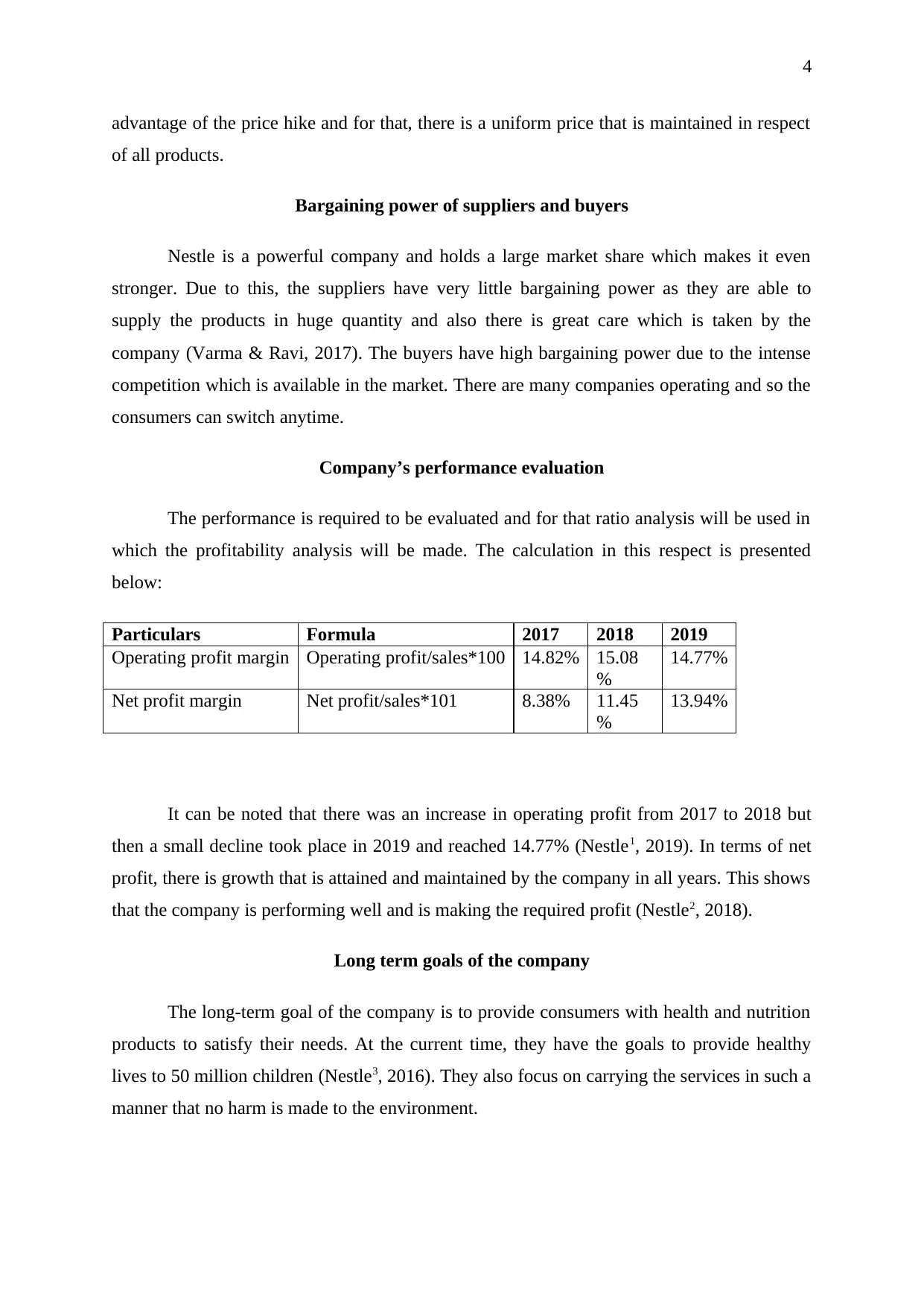
4
advantage of the price hike and for that, there is a uniform price that is maintained in respect
of all products.
Bargaining power of suppliers and buyers
Nestle is a powerful company and holds a large market share which makes it even
stronger. Due to this, the suppliers have very little bargaining power as they are able to
supply the products in huge quantity and also there is great care which is taken by the
company (Varma & Ravi, 2017). The buyers have high bargaining power due to the intense
competition which is available in the market. There are many companies operating and so the
consumers can switch anytime.
Company’s performance evaluation
The performance is required to be evaluated and for that ratio analysis will be used in
which the profitability analysis will be made. The calculation in this respect is presented
below:
Particulars Formula 2017 2018 2019
Operating profit margin Operating profit/sales*100 14.82% 15.08
%
14.77%
Net profit margin Net profit/sales*101 8.38% 11.45
%
13.94%
It can be noted that there was an increase in operating profit from 2017 to 2018 but
then a small decline took place in 2019 and reached 14.77% (Nestle1, 2019). In terms of net
profit, there is growth that is attained and maintained by the company in all years. This shows
that the company is performing well and is making the required profit (Nestle2, 2018).
Long term goals of the company
The long-term goal of the company is to provide consumers with health and nutrition
products to satisfy their needs. At the current time, they have the goals to provide healthy
lives to 50 million children (Nestle3, 2016). They also focus on carrying the services in such a
manner that no harm is made to the environment.
advantage of the price hike and for that, there is a uniform price that is maintained in respect
of all products.
Bargaining power of suppliers and buyers
Nestle is a powerful company and holds a large market share which makes it even
stronger. Due to this, the suppliers have very little bargaining power as they are able to
supply the products in huge quantity and also there is great care which is taken by the
company (Varma & Ravi, 2017). The buyers have high bargaining power due to the intense
competition which is available in the market. There are many companies operating and so the
consumers can switch anytime.
Company’s performance evaluation
The performance is required to be evaluated and for that ratio analysis will be used in
which the profitability analysis will be made. The calculation in this respect is presented
below:
Particulars Formula 2017 2018 2019
Operating profit margin Operating profit/sales*100 14.82% 15.08
%
14.77%
Net profit margin Net profit/sales*101 8.38% 11.45
%
13.94%
It can be noted that there was an increase in operating profit from 2017 to 2018 but
then a small decline took place in 2019 and reached 14.77% (Nestle1, 2019). In terms of net
profit, there is growth that is attained and maintained by the company in all years. This shows
that the company is performing well and is making the required profit (Nestle2, 2018).
Long term goals of the company
The long-term goal of the company is to provide consumers with health and nutrition
products to satisfy their needs. At the current time, they have the goals to provide healthy
lives to 50 million children (Nestle3, 2016). They also focus on carrying the services in such a
manner that no harm is made to the environment.
Paraphrase This Document
Need a fresh take? Get an instant paraphrase of this document with our AI Paraphraser
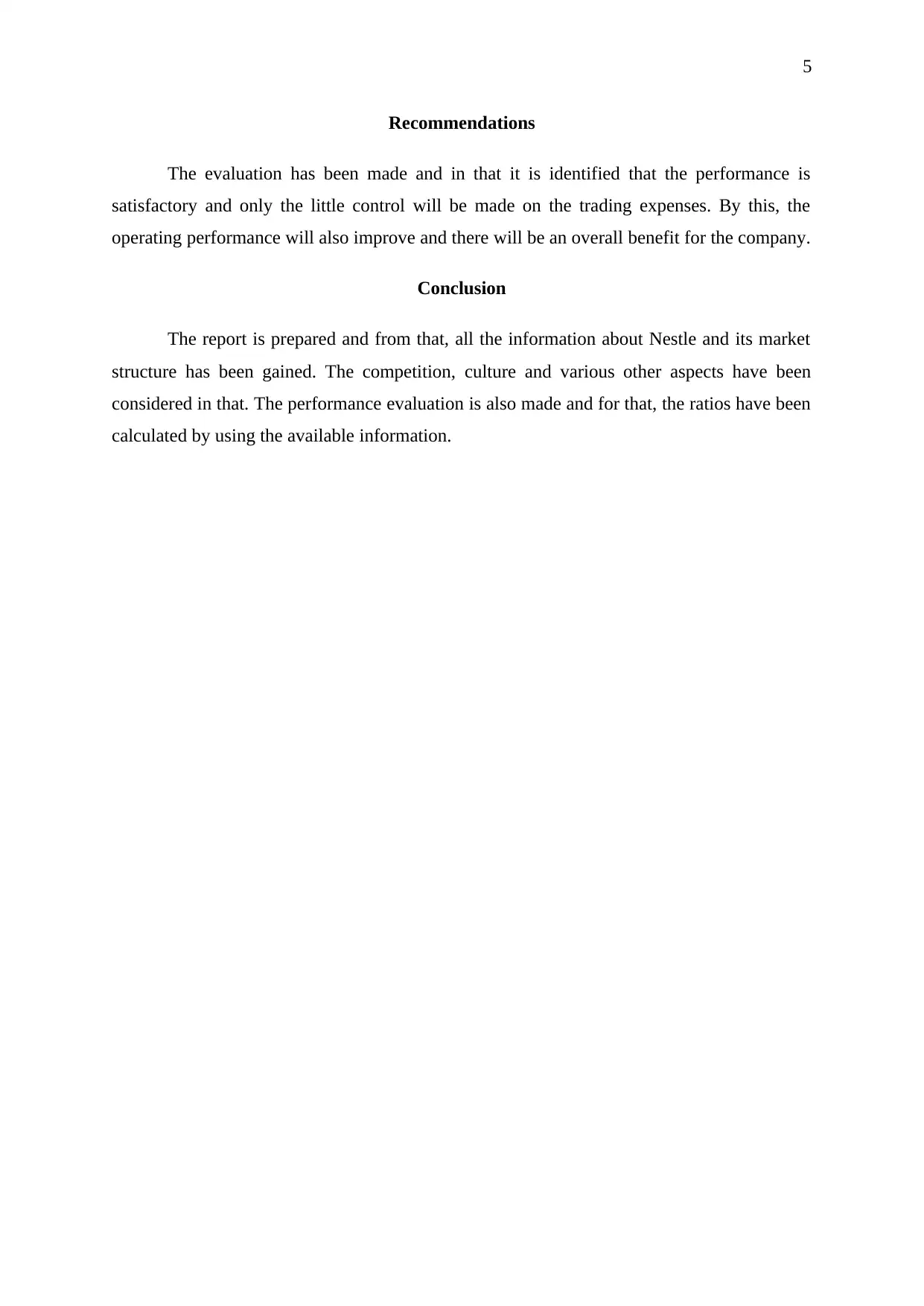
5
Recommendations
The evaluation has been made and in that it is identified that the performance is
satisfactory and only the little control will be made on the trading expenses. By this, the
operating performance will also improve and there will be an overall benefit for the company.
Conclusion
The report is prepared and from that, all the information about Nestle and its market
structure has been gained. The competition, culture and various other aspects have been
considered in that. The performance evaluation is also made and for that, the ratios have been
calculated by using the available information.
Recommendations
The evaluation has been made and in that it is identified that the performance is
satisfactory and only the little control will be made on the trading expenses. By this, the
operating performance will also improve and there will be an overall benefit for the company.
Conclusion
The report is prepared and from that, all the information about Nestle and its market
structure has been gained. The competition, culture and various other aspects have been
considered in that. The performance evaluation is also made and for that, the ratios have been
calculated by using the available information.
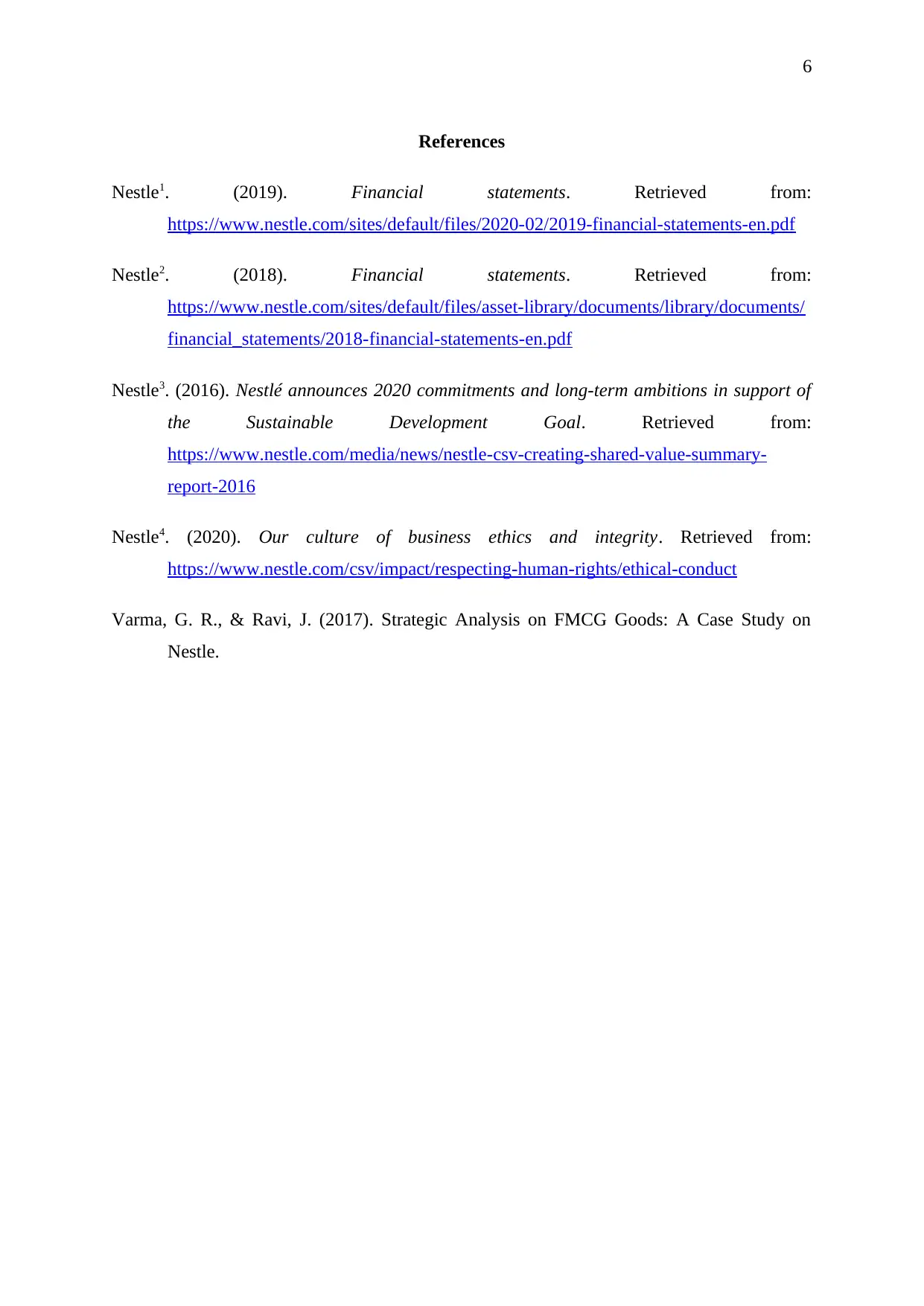
6
References
Nestle1. (2019). Financial statements. Retrieved from:
https://www.nestle.com/sites/default/files/2020-02/2019-financial-statements-en.pdf
Nestle2. (2018). Financial statements. Retrieved from:
https://www.nestle.com/sites/default/files/asset-library/documents/library/documents/
financial_statements/2018-financial-statements-en.pdf
Nestle3. (2016). Nestlé announces 2020 commitments and long-term ambitions in support of
the Sustainable Development Goal. Retrieved from:
https://www.nestle.com/media/news/nestle-csv-creating-shared-value-summary-
report-2016
Nestle4. (2020). Our culture of business ethics and integrity. Retrieved from:
https://www.nestle.com/csv/impact/respecting-human-rights/ethical-conduct
Varma, G. R., & Ravi, J. (2017). Strategic Analysis on FMCG Goods: A Case Study on
Nestle.
References
Nestle1. (2019). Financial statements. Retrieved from:
https://www.nestle.com/sites/default/files/2020-02/2019-financial-statements-en.pdf
Nestle2. (2018). Financial statements. Retrieved from:
https://www.nestle.com/sites/default/files/asset-library/documents/library/documents/
financial_statements/2018-financial-statements-en.pdf
Nestle3. (2016). Nestlé announces 2020 commitments and long-term ambitions in support of
the Sustainable Development Goal. Retrieved from:
https://www.nestle.com/media/news/nestle-csv-creating-shared-value-summary-
report-2016
Nestle4. (2020). Our culture of business ethics and integrity. Retrieved from:
https://www.nestle.com/csv/impact/respecting-human-rights/ethical-conduct
Varma, G. R., & Ravi, J. (2017). Strategic Analysis on FMCG Goods: A Case Study on
Nestle.
⊘ This is a preview!⊘
Do you want full access?
Subscribe today to unlock all pages.

Trusted by 1+ million students worldwide

7
1 out of 7
Related Documents
Your All-in-One AI-Powered Toolkit for Academic Success.
+13062052269
info@desklib.com
Available 24*7 on WhatsApp / Email
![[object Object]](/_next/static/media/star-bottom.7253800d.svg)
Unlock your academic potential
Copyright © 2020–2025 A2Z Services. All Rights Reserved. Developed and managed by ZUCOL.





